MySQL数据库高级SQL语句
2023-12-28 11:33:33
目录
一、高级SQL语句
(一)select:查询语句
1.where:根据条件查询
select '字段' from 表名 where 条件
#示例:显示store_Name和store_info 字段 并且要找到Sales小于1000
select store_name from store_info where Sales > 1000;
2.in:显示已知值的数据
select 字段名 from 表名 where 字段 in (值1,值2....);
select * from store_info where store_name in ('Los Angeles', 'Houston');
#示例:查询store_info表中store_name是Los Angeles和Houston的记录
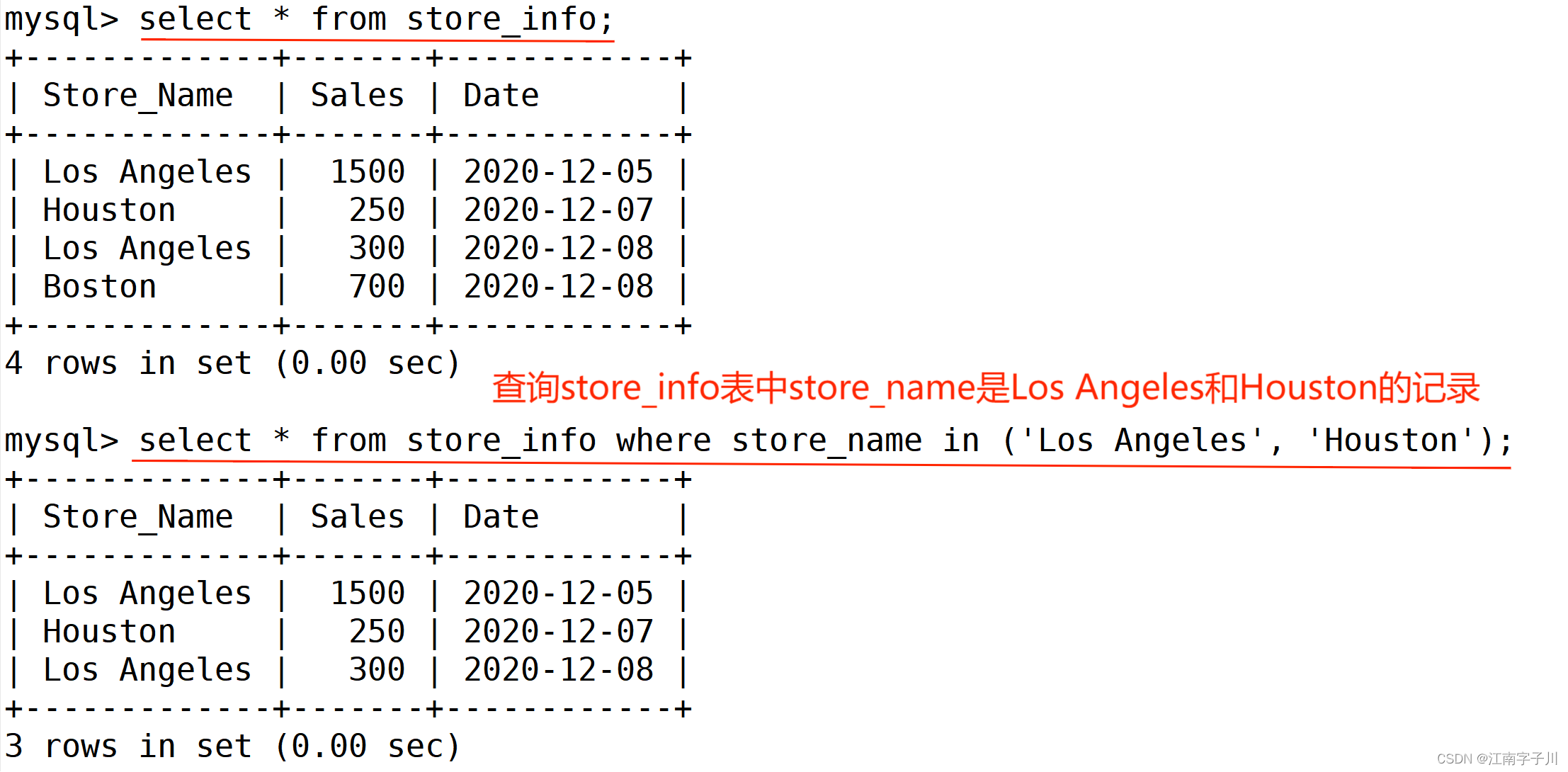
3.not?in:显示除了已知值的数据
select 字段名 from 表名 where 字段 not in (值1,值2....);
select * from store_info where store_name not in ('Los Angeles', 'Houston');
#示例:查询store_info表中除了store_name是Los Angeles和Houston之外的记录

4.between:显示两个值范围内的数据
select 字段名 from 表名 where 字段 between 值1 and 值2;
select * from store_info where date between '2020-12-06' and '2020-12-10';
#示例:查询store_info表中在2020-12-06和2020-12-10之间的记录

5.like+通配符:模糊查询
| 通配符 | 含义 |
|---|---|
| % | 表示零个,一个或者多个字符 |
| _ | 下划线表示单个字符 |
| A_Z | 所有以A开头 Z 结尾的字符串 'ABZ' 'ACZ' 'ACCCCZ'不在范围内 下划线只表示一个字符 AZ 包含a空格z |
| ABC% | 所有以ABC开头的字符串 ABCD ABCABC |
| %CBA | 所有以CBA结尾的字符串 WCBA CBACBA |
| %AN% | 所有包含AN的字符串 los angeles |
| _AN% | 所有 第二个字母为 A 第三个字母 为N 的字符串 |
select 字段 from 表名 where 字段 like '通配符表达式';
select * from store_info where store_name like '%os%';
#示例:查询store_info表中带有os的store_name值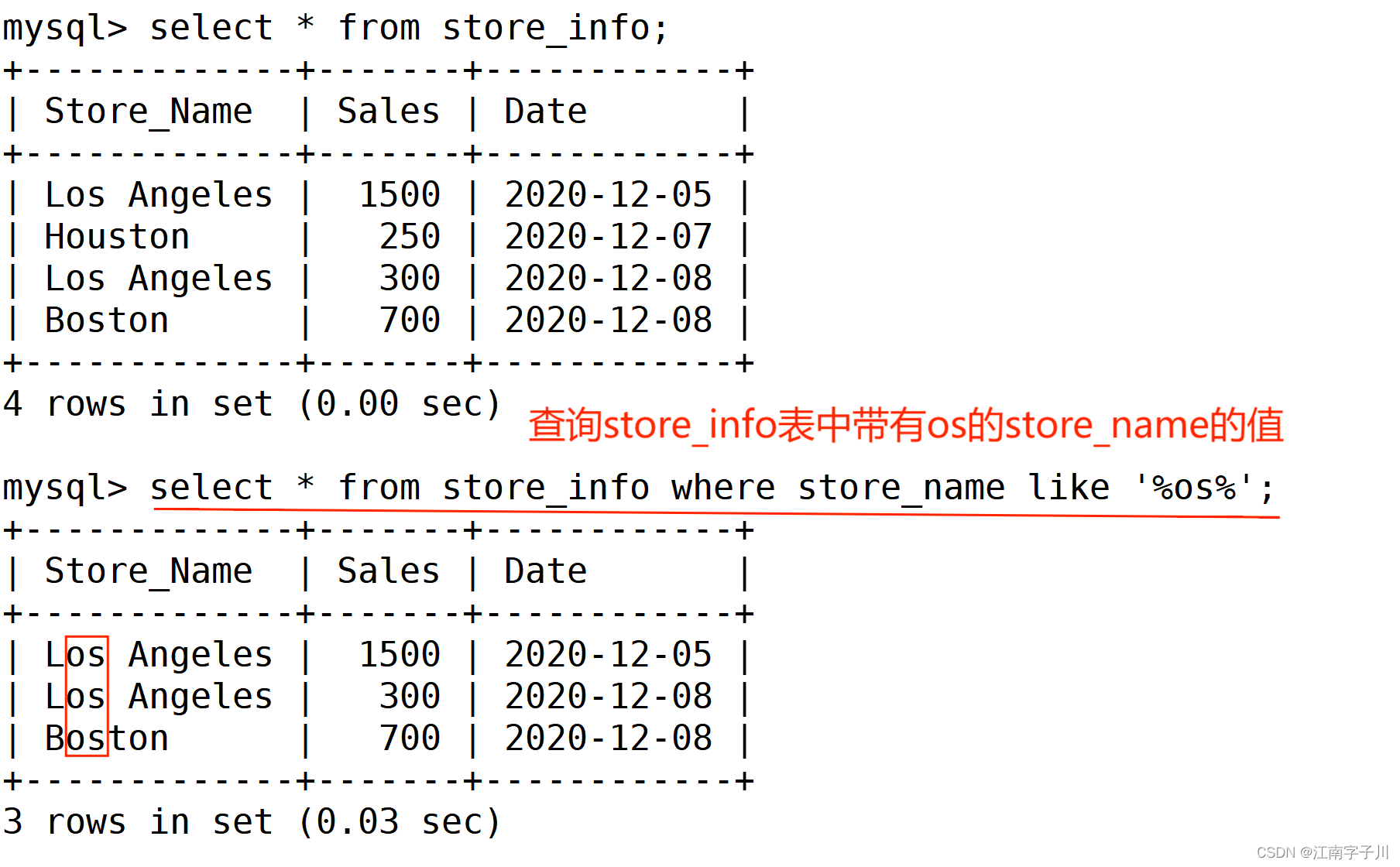
6.order by:按关键字排序
select 字段名 from 表名 where 条件 order by 字段 [asc,desc];
asc :按照升序进行排序的,是默认的排序方式 desc :按降序方式进行排序
select store_name,sales,date from store_info order by Sales desc;
#示例:按store_info表中Sales的大小降序排序
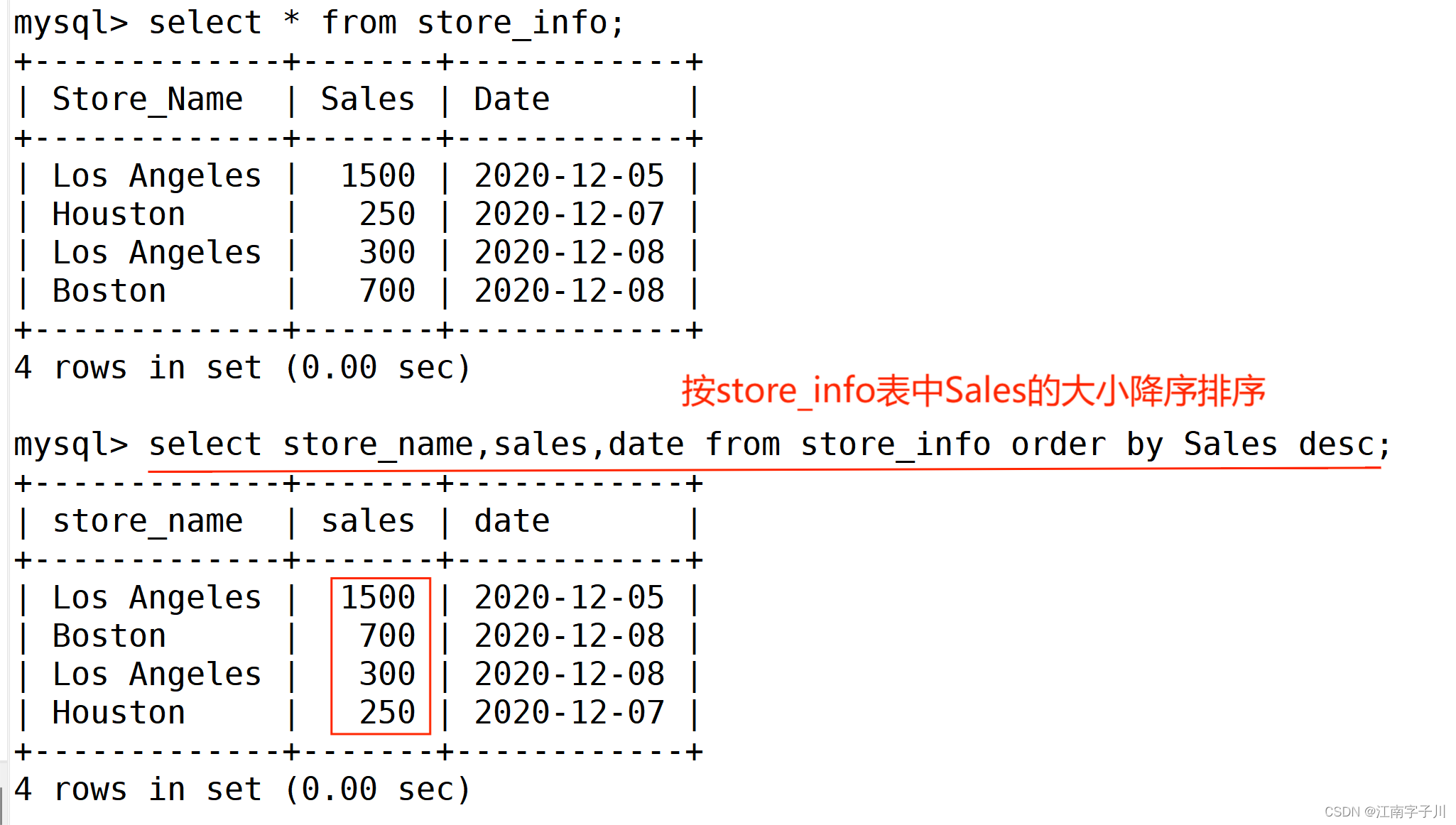
(二)函数
1.数学函数
(1)函数类型
| 函数 | 含义 |
|---|---|
| abs(x) | 返回x 的 绝对值 |
| rand() | 返回0到1的随机数 |
| mod(x,y) | 返回x除以y以后的余数 |
| power(x,y) | 返回x的y次方 |
| round(x) | 返回离x最近的整数 |
| round(x,y) | 保留x的y位小数四舍五入后的值 |
| sqrt(x) | 返回x的平方根 |
| truncate(x,y) | 返回数字 x 截断为 y 位小数的值 |
| ceil(x) | 返回大于或等于 x 的最小整数 |
| floor(x) | 返回小于或等于 x 的最大整数 |
| greatest(x1,x2.....) | 返回返回集合中最大的值 |
| least(x1,x2..........) | 返回返回集合中最小的值 |
(2)示例
SELECT abs(-1), rand(), mod(5,3), power(2,3), round(1.89);
#返回-1的平均值,0-1的随机数,5除以3的余数,2的3次方,距离1.89最近的整数
SELECT round(1.8937,3), truncate(1.235,2), ceil(5.2), floor(2.1), least(1.89,3,6.1,2.1);
#返回数字1.8937的3位小数四舍五入后的值,数字1.235截断为2位小数的值,大于或等于5.2 的最小整数,小于或等于2.1的最大整数,集合中最小的值
2.聚合函数
(1)函数类型
| 函数 | 含义 |
|---|---|
| avg() | 返回指定列的平均值 |
| count() | 返回指定列中非 NULL 值的个数 |
| min() | 返回指定列的最小值 |
| max() | 返回指定列的最大值 |
| sum(x) | 返回指定列的所有值之和 |
(2)示例
select avg(Sales) from store_info;
#返回表中营业额的平均值
select count(Store_Name) from store_info;
#返回Store_Name中非 NULL 值的个数
select count(distinct Store_Name) from store_info;
#返回Store_Name中不重复的非 NULL 值的个数
select max(Sales) from store_info;
#返回表中营业额的最大值
select min(Sales) from store_info;
#返回表中营业额的最小值
select sum(Sales) from store_info;
#返回表中营业额所有值之和


3.字符串函数
(1)函数类型
| 函数 | 描述 |
|---|---|
| concat(x,y) | 将提供的参数 x 和 y 拼接成一个字符串 |
| substr(x,y,z) | 获取从字符串 x 中的第 y 个位置开始长度为z 的字符串 |
| eplace(x,y,z) | 将字符串 z 替代字符串 x 中的字符串 y |
| length(x) | 返回字符串 x 的长度 |
| lower(x) | 将字符串 x 的所有字母变成小写字母 |
| left(x,y) | 返回字符串 x 的前 y 个字符 |
| right(x,y) | 返回字符串 x 的后 y 个字符 |
| repeat(x,y) | 将字符串 x 重复 y 次 |
| space(x) | 返回 x 个空格 |
| strcmp(x,y) | 比较 x 和 y,返回的值可以为-1,0,1 |
| reverse(x) | 将字符串 x 反转 |
| trim() | 返回去除指定格式的值 |
| substr(x,y) | 获取从字符串 x 中的第 y 个位置开始的字符串,跟substring()函数作用相同 |
| upper(x) | 将字符串 x 的所有字母变成大写字母 |
(2)示例
①??concat(字段1, 字段2, ....)?
拼接字段
select concat(Region, Store_Name) from location where Store_Name = 'Boston';
#将location表中的Region和Store_Name字段拼接起来
②?字段1 || 字段2??
字段拼接
select Region || ' ' || Store_Name FROM location where Store_Name = 'Boston';
#将location表中的Region和Store_Name字段以空格为分隔符拼接起来
③?substr(x,y,z)?
获取从字符串 x 中的第 y 个位置开始长度为z 的字符串
select substr(Store_Name,2,4) from location where Store_Name = 'New York';
#提取location表中Store_Name字段从第2个字符,4个字符长度的字段内容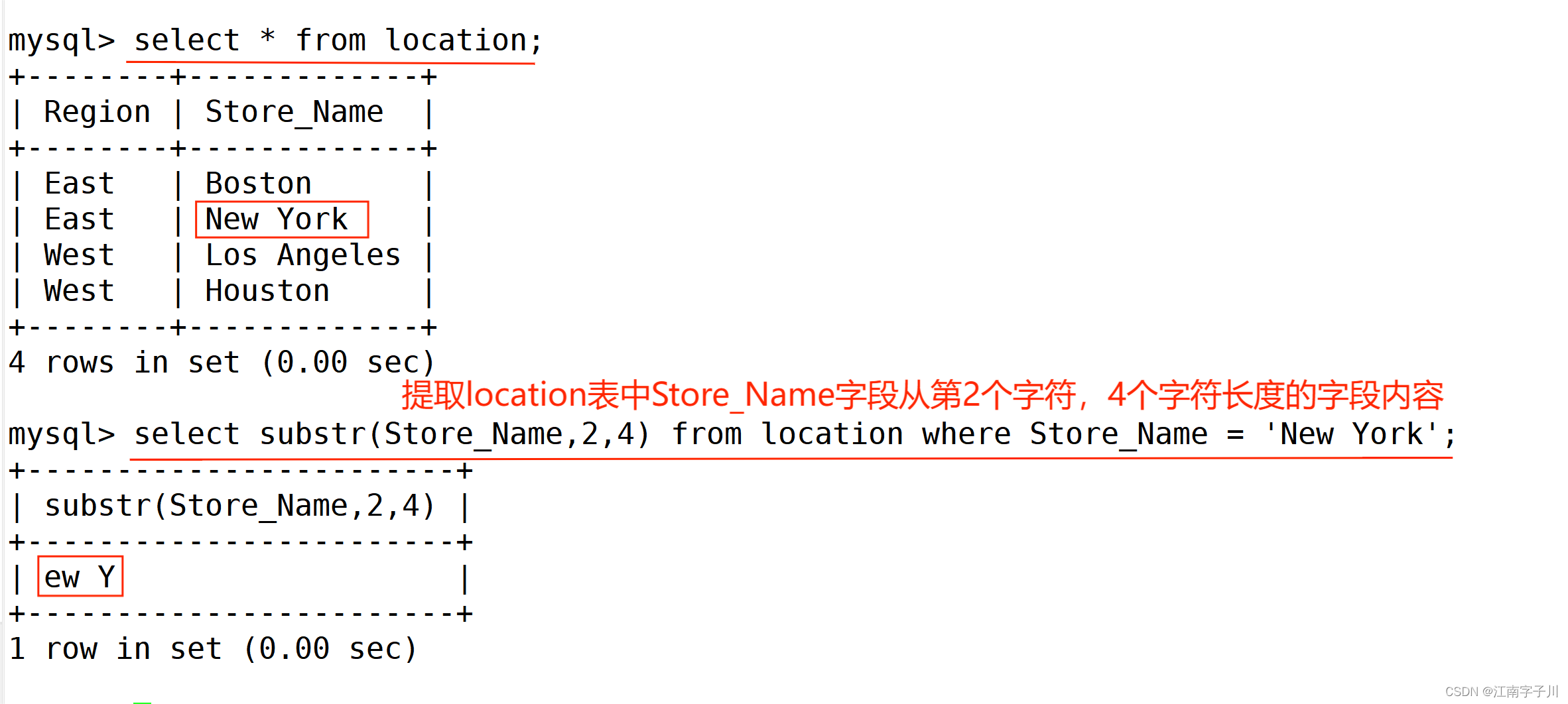
④?length(x)
统计字符长度
select Store_Name,length(Store_Name) from location;
#统计Store_Name字段中字符的长度
⑤ 替换
select replace(Store_Name,'on','aa') from location;
#将location表中Store_Name字段记录的字符中的on替换成aa
(三)group by分组
查询结果进行汇总分组,
-
对group by 后面的字段的查询结果进行汇总分组,通常是结合聚合函数一起使用的
-
group by 有一个原则,就是select 后面的所有列中,没有使用聚合函数的列必须出现在 group by 的后面
1.group by
select 字段1,sum(字段2) from 表名 group by 字段1;
select Store_Name, sum(Sales) from store_info group by Store_Name order by sales desc;
#示例:求store_info表中相同Store_Name营业额的总和并和Store_Name一起按降序排列
2.having
根据group by分组后的结果再进行条件过滤
select 字段,聚合函数(字段) from 表 group by 字段 having 条件表达式;
select Store_Name, sum(Sales) from store_info group by Store_Name having sum(Sales) > 1500;
#示例:求store_info表中相同Store_Name营业额的总和并显示Store_Name和营业额大于1500的记录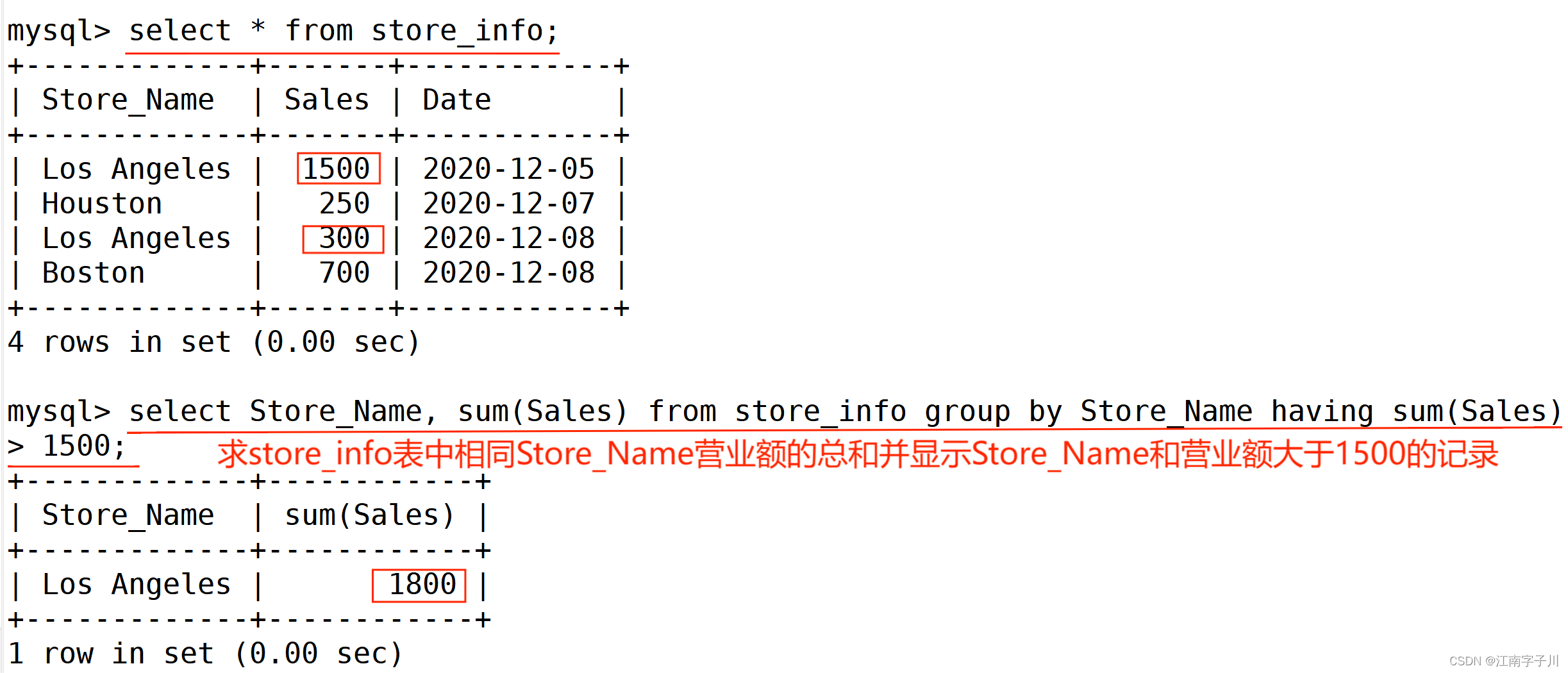
(四)as:别名
select "表格別名"."字段1" [AS] "字段別名" from "表格名" [AS] "表格別名";
select A.Store_Name Store, sum(A.Sales) "Total Sales" from store_info A group by A.Store_Name;
#示例:设置表名别名为A,基于营业额总和,将其按降序排列并分组后的表sum(Sales)定义别名为Total Sales
(五)连接查询
先准备location和store_info两个表
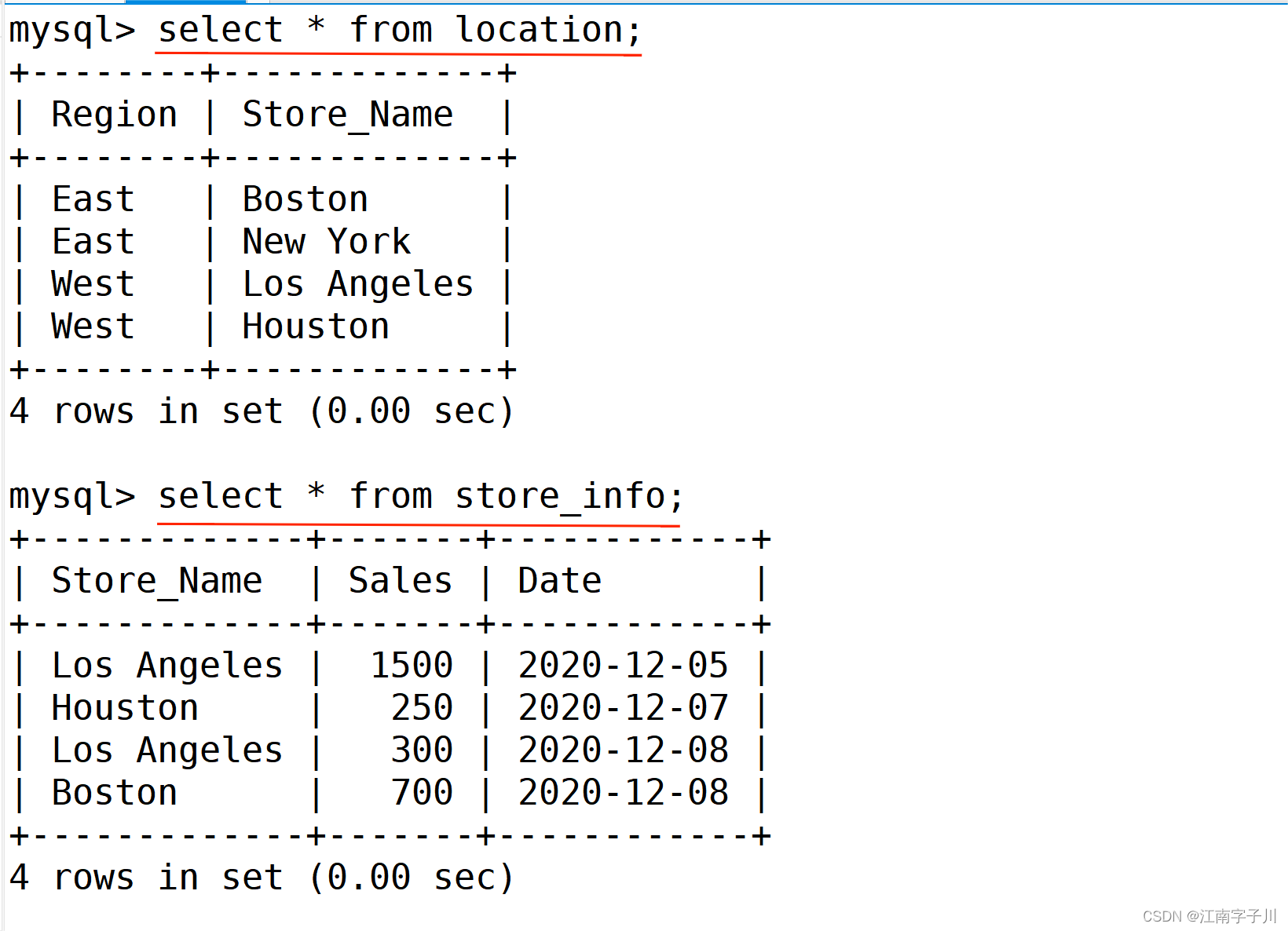
1.inner join(内连接)
只返回两个表中联结字段相等的行
select * from location A inner join store_info B on A.Store_Name = B.Store_Name ;
#返回location表和store_info表中Store_Name字段相等的行
2.left join(左连接)
返回包括左表中的所有记录和右表中联结字段相等的记录,不相等的行返回null
select * from location A left join store_info B on A.Store_Name = B.Store_Name ;
#返回包括location左表中的所有记录和store_info右表中Store_Name字段相等的行记录,不相等的行返回null
3.right join(右连接)
返回包括右表中的所有记录和左表中联结字段相等的记录,不相等的行返回null
select * from store_info A left join location B on A.Store_Name = B.Store_Name ;
#返回包括store_info右表中的所有记录和location左表中Store_Name字段相等的行记录,不相等的行返回null
(六)联集
将两个SQL语句的结果合并起来,两个SQL语句所产生的字段需要是同样的数据记录种类

1.union
生成结果的数据记录值将没有重复,且按照字段的顺序进行排序
[select 语句 1] union [select 语句 2];
select Store_Name from location union select Store_Name from store_info;
#示例:将location和store_info表中的Store_Name字段记录合并、去重
2.union all
将生成结果的数据记录值都列出来,无论有无重复
[select 语句 1] union all [select 语句 2];
select Store_Name from location union all select Store_Name from store_info;
#示例:将location和store_info表中的Store_Name字段所有记录合并,不去重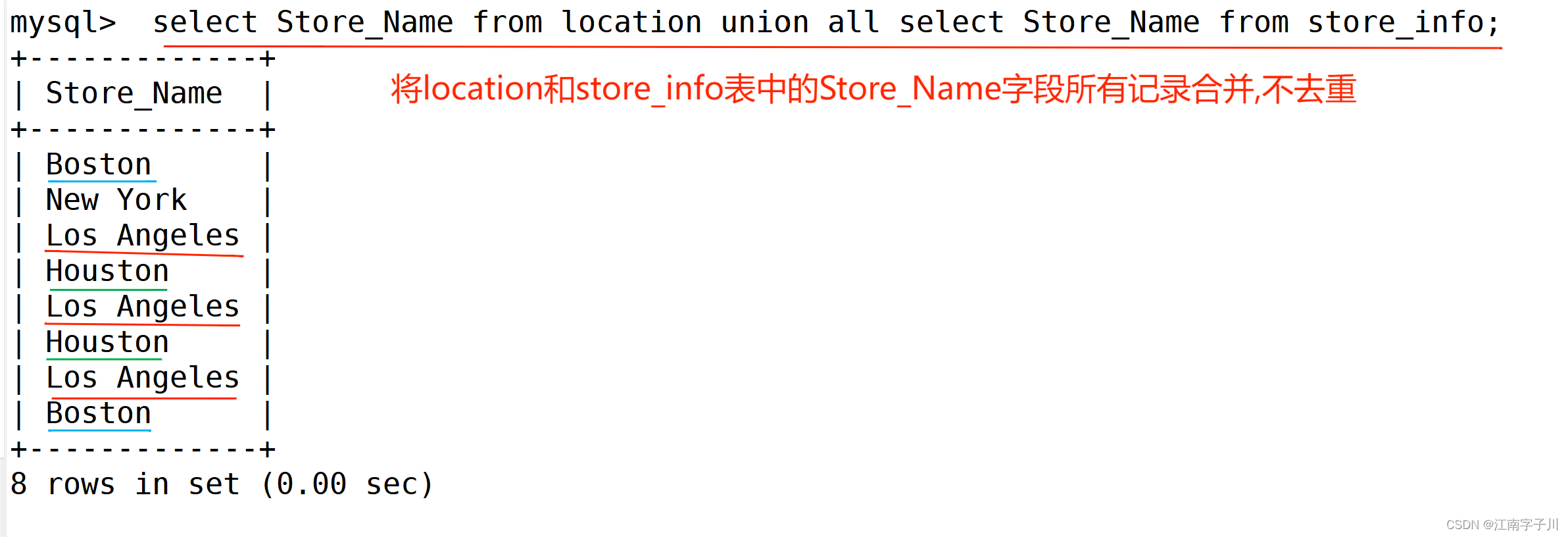
(七)子查询
连接表格,在where子句或having子句中插入另一个SQL语句
在where子句或having子句中插入的另一个SQL语句为内查询,其查询结果作为外查询(where子句或having子句)的查询条件
select A.字段 from 左表 A where A.字段 in (select B.字段 from 右表 B);
select Store_Name from location where (Store_Name) in (select Store_Name from store_info);
#示例:查询显示location表中Store_Name字段,其取值范围在store_info中的Store_Name字段
(即查询location表和store_info中Store_Name字段相等的行记录)
文章来源:https://blog.csdn.net/byq002488/article/details/135250956
本文来自互联网用户投稿,该文观点仅代表作者本人,不代表本站立场。本站仅提供信息存储空间服务,不拥有所有权,不承担相关法律责任。 如若内容造成侵权/违法违规/事实不符,请联系我的编程经验分享网邮箱:veading@qq.com进行投诉反馈,一经查实,立即删除!
本文来自互联网用户投稿,该文观点仅代表作者本人,不代表本站立场。本站仅提供信息存储空间服务,不拥有所有权,不承担相关法律责任。 如若内容造成侵权/违法违规/事实不符,请联系我的编程经验分享网邮箱:veading@qq.com进行投诉反馈,一经查实,立即删除!